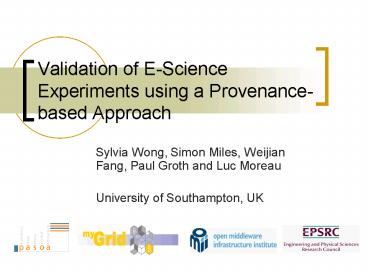Validation of E-Science Experiments using a Provenance-based Approach - PowerPoint PPT Presentation
1 / 19
Title:
Validation of E-Science Experiments using a Provenance-based Approach
Description:
Validation of E-Science Experiments using a Provenance-based Approach. Sylvia Wong, Simon Miles, Weijian Fang, Paul Groth and Luc Moreau. University of Southampton, UK ... – PowerPoint PPT presentation
Number of Views:29
Avg rating:3.0/5.0
Title: Validation of E-Science Experiments using a Provenance-based Approach
1
Validation of E-Science Experiments using a
Provenance-based Approach
- Sylvia Wong, Simon Miles, Weijian Fang, Paul
Groth and Luc Moreau - University of Southampton, UK
2
Overview
- E-Science experiment validation
- Bioinformatics scenario
- Provenance-based validation architecture
- Evaluation results
3
E-Science Experiments
- Large scale computations for conducting
scientific research - Multiple distributed services on the Grid
- Workflow validation
- Part of the scientific process
- Verify correctness of their own experiments
- Review correctness of their peers' work
4
Static Validation
- Operates on workflow source code
- Checks if workflow satisfies some properties
before it is run - Examples
- type inference, escape analysis, concurrency
analysis, graph-based partitioning - Workflow script may not be accessible or may be
expressed in a language not supported by analysis
tool
5
Dynamic Validation
- Verifies data values satisfy constraints during
execution - interface matching, runtime type checking
- Cannot assume services will perform validation
- Interfaces may be under-specified
- In bioinformatics, biological sequences commonly
specified as strings in interfaces
6
Provenance-based Validation
- Allows for validation of experiments after
execution - Third parties may want to verify that the
results obtained were computed correctly
according to some criteria - These criteria may not be known when the
experiment was designed or run - Important because science progresses (and models
evolve!)
7
Bioinformatics Scenario
- A biologist has a set of proteins, for each of
which he/she wishes to determine a particular
biological property
?
8
Experiment Services
- Service C
- .
- ..
- .
- Design experiment (abstract plan)
- For each step in the plan, decide on the concrete
service to use - Each service may be designed by the biologist or
adopted from the work of another biologist - For each service there is a description of that
service stating - what the service does
- what type of data it analyses (its inputs) and
- what type of results it produces (its outputs)
- All the descriptions are stored in a registry
- Service B
- .
- ..
- .
- Service A
- .
- ..
- .
Registry
Description of Service A Function .. Inputs
.. Outputs ..
9
Performing Experiment
- Service A
- .
- ..
- Performs experiment
- Details of experimental process documented in a
provenance store - Each service documenting its own execution
- Service B
- .
- ..
- Service C
- .
- ..
- Service D
- .
- ..
- Service E
- .
- ..
10
Questions
- Did I perform each service on the type of data
that the service was intended to analyse? - Were the inputs and outputs of each activity
compatible? - Did the services I used actually fulfil my high
level plan?
11
Answering the Questions
- Using the documentation in the Provenance Store,
we can reconstruct the process that led to each
result - Along with the high level plan and the
descriptions in the registry we have all the
information required to answer the questions
12
Q1 Were the inputs and outputs compatible?
Retrieve descriptions for each service
A
Retrieve each pair of services performed in an
experiment, where one services output is the
others input
B
Description of Service A Function .. Inputs
.. Outputs ..
Description of Service B Function .. Inputs
.. Outputs ..
Compare the output type of the first service with
the input type of the second
13
Q2 Did the experiment follow the plan?
Retrieve procedure descriptions
Compare procedure function to planned activity
Description of Service A Function .. Inputs
.. Outputs ..
Retrieve documentation of experiment that led to
a result
A
?
14
Ontological Reasoning
Ontology
- High-level activity may be described in a more
general way than the service which performs it - Also, one services input may be a generalisation
of the preceding services output - Therefore, exact matching of types may produce a
false negative the biologist will wrongly be
told the experiment was invalid - By using an ontology, describing how types are
related, we can reason about types and determine
whether they are truly compatible
PPMZ
is generalisation of
Compression Algorithm
15
Architecture
service providers
16
Testing
- Workflow - protein compressibility
- Provenance store PASOA (pasoa.org)
- Registry Grimoires (grimoires.org)
- Validator Java, Jena 2.1
- Ontology in OWL, based on myGrid bioinformatics
ontology
17
Performance Evaluation
- Potentially, large number of experiments are
performed - Evaluate if our approach can scale with the size
of the provenance store - Time to validate an experiment with increasing
number of experiments recorded
18
Performance
input/output type validation
plan validation
19
Summary
- Provenance-based validation of workflow
executions - Validation of experiments after execution
- Previously unknown criteria
- Third party validation
- Tested with a sample bioinformatics experiment
- Evaluation shows framework scales well with
increasing data store size































